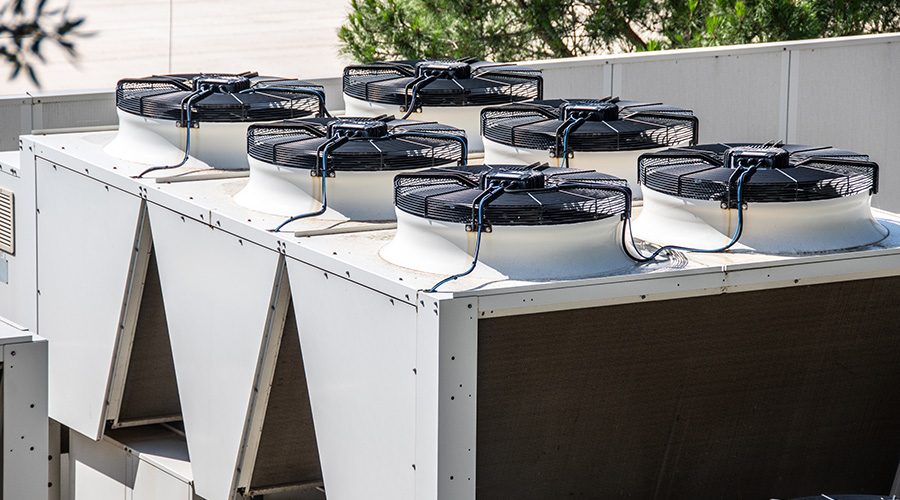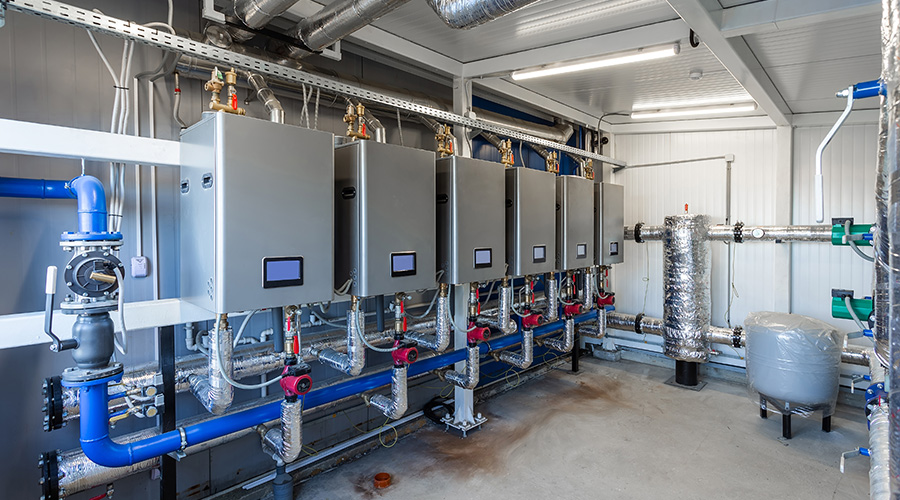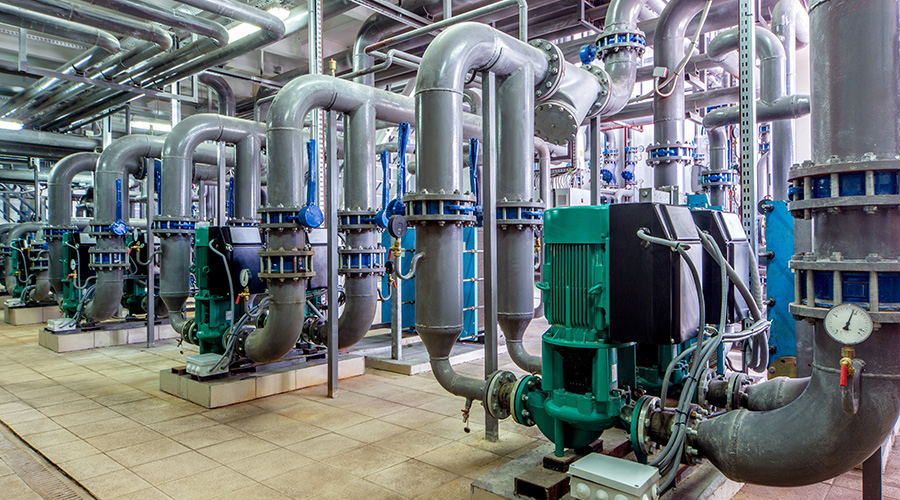Water Heaters: Avoiding ‘Hot Water’
Properly specified, installed and maintained, systems can help facilities avoid problems related to occupant comfort and energy use
Domestic water heaters found in institutional and commercial facilities provide an often-overlooked opportunity to save energy. Depending on the facility and its demand for domestic hot water, these systems can account for 10-18 percent of total energy use.
With the use of new technology and proper maintenance of the installed systems, engineering and maintenance managers can reduce the energy requirements of these systems by up to 50 percent. And while much of the attention of new technology focuses on improved operating efficiency, these systems also can improve safety for operators and building occupants.
Condensing Water Heaters
Conventional gas-fired water heaters have a peak operating efficiency of 78-82 percent. They burn fuel in a combustion chamber, and the resulting combustion gasses pass through a heat exchanger, which transfers energy from the gasses to water. Much of the operating loss in these units comes in the form of heat carried out of the unit with the flue gases
Water — a natural byproduct of combustion vapor — carries out part of the energy lost in the flue gases. Condensing water heaters recover much of this energy by using a larger heat exchanger or a second heat exchanger that reduces the flue-gas temperature to the point where this water vapor condenses, releasing even more energy.
Condensing water heaters offer a peak operating efficiency of 88-90 percent. Managers typically can recover their extra cost in one to two years’ operation in most facilities and less in facilities with high hot-water demand.
Modulating Systems
Conventional water heaters use on/off controls. As the system load varies, the boiler varies the amount of time it is on to meet the demand. Higher demand levels result in longer burn times, and lower demand levels result in longer periods when the burner is off. Only when the boiler operates at peak load does the burner remain on for a long period of time.
While on/off controls are simple and inexpensive, they are not very efficient. Water heaters that cycle frequently increase losses through the boiler’s flue gases. Depending on the frequency with which the water heater must cycle, these losses can reduce annual operating efficiency 10-50 percent.
Modulating water heaters offer an effective solution for reducing these losses. Instead of simply shutting off the burner when the system meets the demand for hot water, modulating boilers reduce the amount of fuel supplied to the boiler, cutting the rate at which hot water is generated without turning off the burner. Only when demand drastically falls off is the burner actually shut down. Modulating the burner instead of cycling reduces flue-gas losses and increases annual operating efficiencies by up to 50 percent.
New-generation water heaters that modulate the burner while condensing the flue gases can achieve operating efficiencies as high as 92-95 percent.
Modular Units
In most commercial and institutional facilities, one water heater is sized to meet the facility’s peak demand. In most facilities though, the demand for hot water varies widely with time of day and day of the week, often by a factor of 10 or more. For conventional water heaters, this means the unit will cycle frequently most of the time. Modulating water heaters reduce the cycling, which still will take place during periods of relatively low demand.
An alternative to the single water heater is using multiple, modular units sized to meet a range of hot-water-demand levels. Each modular unit has a much lower capacity that the single, conventional unit. Under low-load conditions, one water heater can provide all of the required hot water. As the load increases, additional units automatically come on line. Depending on the application and the demand for hot water, a facility might have up to 10 modular units.
Modular installation — using multiple, smaller water heaters — delivers increased annual operating efficiency over the use of a conventional single unit. The degree of improvement depends on the range of demand for hot water. Managers can expect that for most typical applications, a modular water heater approach can reduce annual energy requirements by at least 10 percent.
The use of modular water heaters also means facilities have backup hot-water units available. In a single-water-heater application, one unit failure results in a loss of hot water. But in a modular application, one heater’s failure only reduces system capacity. Hot water is still available.
Point-of-use Heaters
In traditional hot-water systems, a central heater generates hot water, which then is distributed through a piping system to all points of use. Larger systems might require circulation pumps and storage tanks.
One major drawback of a central system is its overall operating efficiency. Typically, water must run for several seconds for hot water to reach each point of use, wasting both water and the energy used to heat it. Conduction losses from system piping and storage tanks further decreases operating efficiency. Circulation pumps require additional energy. As a result, it is not uncommon to find that the annual operating efficiency of central systems is 50 percent or less.
Point-of-use water heaters offer an alternative to the central hot water system. Instead of a single or multiple central water heaters, point-of-use systems feature multiple small water heaters throughout a facility at or near the point where the water is needed.
Heaters are sized to meet the demand of that use. They might be instantaneous water heaters or might include a small tank. By eliminating losses associated with central systems, point-of-use water heaters offer vastly improved annual operating efficiencies. Their primary drawback is the additional maintenance required needed to keep the larger number of system components operating and in good condition.
Heat-pump Water Heaters
The most efficient water heater is the electric resistance unit, which has an average efficiency greater than 97 percent. While this heater is the most efficient, it also is the most expensive to operate due to the high cost of electricity, compared to other water-heating fuel sources.
New heat-pump water-heater technology offers an electric alternative that has the advantages of very high efficiency and low operating cost. It produces about three times the quantity of hot water for the same amount of electricity.
Heat-pump water-heaters operate the same way that HVAC-system heat pumps do. They extract heat from the air and transfer it to the water. New-generation units are small and can readily serve as direct replacements for a range of water heater types and sizes.
Maintenance
No matter the type of water heater system installed, maintenance is essential for long-term performance, safety and high operating efficiency. Unfortunately, too many organizations simply ignore most systems until something goes wrong. Water heaters are like any other installed system; maintenance departments must maintain them through a program of regular inspection and testing.
Maintenance requirements vary with the size and type of equipment. Technicians should inspect all hot water outlets at least monthly for proper operation and leaks. No matter how efficiently the system provides hot water, waste through leaks and valves that won’t fully close increases both energy and water costs.
Technicians also should test and adjust water supply temperature controls at least monthly, and they should inspect the entire system annually for leaks, as well as damage to components and insulation. They should flush all storage tanks annually to remove sediment, and they should inspect larger tanks annually for scale. Finally, to promote safety for mechanics and building occupants, they should test all pressure-relief valves annually.
By following these routine maintenance tasks and by upgrading systems, managers can generate significant savings through reduced energy and water use.
Spotlight on Safety
New-generation water heaters can reduce the chances of a flashback fire where the water heater is installed. One safety problem related to the use of natural gas- and propane-fueled water heaters is the chance that the heater's flame will ignite flammable vapors in the room.
New flammable vapor ignition resistant (FVIR) designs can prevent this type of ignition by trapping and burning gas vapors within the heater, preventing the ignition of flammable vapors present in the space.
FVIR water heaters are marketed primarily to the residential market. But since the commercial and institutional market widely uses residential type water heaters, they can help improve safety in these applications, as well. This technology is particularly important when considering the type of materials found stored in spaces near water heaters.
|
James Piper, P.E., Ph.D., is a national facilities consultant based in Bowie, Md. He has more than 25 years of experiences in facilities management and maintenance issues.
Related Topics:











